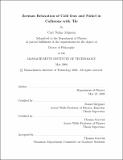| dc.contributor.advisor | Daniel Kleppner and Thomas Greytak. | en_US |
| dc.contributor.author | Johnson, Cort Nolan | en_US |
| dc.contributor.other | Massachusetts Institute of Technology. Dept. of Physics. | en_US |
| dc.date.accessioned | 2009-04-29T14:49:23Z | |
| dc.date.available | 2009-04-29T14:49:23Z | |
| dc.date.copyright | 2008 | en_US |
| dc.date.issued | 2008 | en_US |
| dc.identifier.uri | http://hdl.handle.net/1721.1/45168 | |
| dc.description | Thesis (Ph. D.)--Massachusetts Institute of Technology, Dept. of Physics, 2008. | en_US |
| dc.description | This electronic version was submitted by the student author. The certified thesis is available in the Institute Archives and Special Collections. | en_US |
| dc.description | Includes bibliographical references (p. 143-148). | en_US |
| dc.description.abstract | This thesis describes a measurement of the ratio of elastic to Zeeman-projection changing collision cross sections ([gamma]) in the Fe-3He and Ni-3He systems. This ratio is a probe of the anisotropy of the interaction between the colliding species. Theory and experiment confirm that Zeeman-projection collisions are suppressed in transition metals due to the presence of a spherically symmetric, full 4s shell, making them good candidates for loading a magnetic trap with the buffer gas cooling method. Nickel and iron atoms are introduced via laser ablation into an experimental cell containing a background 3He buffer gas. Elastic collisions with the buffer gas thermalize the atoms to less than 1K. The highest energy mJ = J Zeeman state decays via diffusion through the buffer gas and collisional Zeeman relaxation. Therefore the mJ = J lifetime depends on the buffer gas density of the cell. By measuring the mJ = J lifetime as a function of buffer gas density we determine [gamma]. We find [gamma] for Ni [3F4, mJ = 4] is between 2 x 103 and 1:1 x 104 at 0.75 K in a 0.8 T magnetic field. Zeeman relaxation in Fe [5D4, mJ = 4] occurs on time scales too rapid for us to measure accurately, and we are only able to set an upper bound of [gamma] < 3 x 103. The nickel result confirms that Zeeman relaxation is highly suppressed in submerged shell transition metal atoms. | en_US |
| dc.description.statementofresponsibility | by Cort Nolan Johnson. | en_US |
| dc.format.extent | 148 p. | en_US |
| dc.language.iso | eng | en_US |
| dc.publisher | Massachusetts Institute of Technology | en_US |
| dc.rights | M.I.T. theses are protected by
copyright. They may be viewed from this source for any purpose, but
reproduction or distribution in any format is prohibited without written
permission. See provided URL for inquiries about permission. | en_US |
| dc.rights.uri | http://dspace.mit.edu/handle/1721.1/7582 | en_US |
| dc.subject | Physics. | en_US |
| dc.title | Zeeman relaxation of cold iron and nickel in collisions with ³He | en_US |
| dc.type | Thesis | en_US |
| dc.description.degree | Ph.D. | en_US |
| dc.contributor.department | Massachusetts Institute of Technology. Department of Physics | |
| dc.identifier.oclc | 318124440 | en_US |
